Are you a Quiet Speculation member?
If not, now is a perfect time to join up! Our powerful tools, breaking-news analysis, and exclusive Discord channel will make sure you stay up to date and ahead of the curve.
Confession time: one of my pet cards is Smallpox. That might seem weird coming from an attacks-loving aggro-control enthusiast such as myself, but Smallpox has a lot of the elements I prize in a card: its symmetry makes it innocuous; its floor is low, and its ceiling miles high; its conditions ask pilots to build around it, rather than slot it into existing decks. After Tom Ross's success last weekend on 8-Rack, I figured now's as good a time as any to unveil a Smallpox brew of my own.

In this article, we'll take a look at both decks and discuss the different applications of Smallpox.
Smallpox and 8-Rack
On September 17, 2016, Tom Ross piloted his build of 8-Rack to 7th place of a Star City Games Modern Open. Tom's build eschews Ensnaring Bridge for Smallpox, making his list more of an attrition-based midrange deck than a prison one.
In an elegant Mind Twist-of-fate, exactly one year later, Tom Ross piloted a nearly identical deck to 4th place of another Open: SCG Louisville. This updated version swaps three of its four Dismembers out for Fatal Push, and runs a single Marsh Flats over a Swamp (the sideboard does get a significant overhaul).
Here's his list:
8-Rack, by Tom Ross (4th, SCG Louisville)
Explaining 8-Rack
Tom has written three comprehensive articles covering his take on 8-Rack, so I won't delve too deeply into the deck's inner workings. But for our purposes, we will briefly examine what this deck does and why it succeeds.
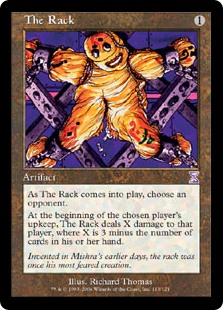
Superficially, 8-Rack's got a simple gameplan: shred opponent's hand, stick The Rack, apply a little more disruption, win. It even claims victory via clocking, or delivering set amounts of damage over multiple turns, contributing to its unintuitive status as something of an aggro-control deck. 8-Rack can be broken down into threats (Rack effects) and disruption (targeted discard and removal), as can Jund or Grixis Shadow.
What are the pros and cons of 8-Rack over those decks? Smallpox makes it challenging to play creatures, meaning flexible options like Tarmogoyf and Scavenging Ooze go out the window. It also strains the manabase, complicating splashes. And targeted discard, the deck's principle form of disruption, can prove lackluster in certain matchups (vs. Affinity, for instance).
On the bright side, removal spells are totally blanked by this deck; pilots can Inquisition turn one and take a card that advances the opponent's gameplan rather than a stranded Fatal Push, which can't be said of traditional midrange decks. 8-Rack's functional threats are tougher to remove than creatures. The deck's configuration also makes its mana a breeze, if limiting its sideboard options.
The Next Step
My problem with using Rack effects as threats are threefold. For one, I don't like how many slots they take up. Having historically favored standalone threats like Delver of Secrets and Thought-Knot Seer, leaning too deep into synergy territory turns me off. The Rack and Shrieking Affliction are only threats when backed up with a steady stream of discard effects.
Second, I like to have outs in my deck, and black alone doesn't offer much in the way of hosers or interaction for noncreature permanents. I imagine 8-Rack players sometimes scoops to an unfortunate card (i.e. Leyline of Sanctity) or boardstate opponents manage to assemble (i.e. a couple of menacing planeswalkers) without having outs for the scenario in the deck. And lastly, I just really like attacking. Perhaps too much. Animating Mutavault's all good and well, but I don't feel like I'm really playing Magic if I can't draw for turn and immediately turn a creature sideways.
 As a result, my Smallpox decks have always omitted Rack effects and played creatures, starting with Tarmogoyf back in 2013. I realize Tom's got answers to my beefs, i.e. expect tons of Leylines? Don't play 8-Rack. But when I sleeve up a Smallpox deck, it's not to crush everyone in my path with a slick metagame call; it's to get what I want out of the game, which always includes attacking, and at that time happens to also include casting Smallpox.
As a result, my Smallpox decks have always omitted Rack effects and played creatures, starting with Tarmogoyf back in 2013. I realize Tom's got answers to my beefs, i.e. expect tons of Leylines? Don't play 8-Rack. But when I sleeve up a Smallpox deck, it's not to crush everyone in my path with a slick metagame call; it's to get what I want out of the game, which always includes attacking, and at that time happens to also include casting Smallpox.
To clarify, I don't think 8-Rack is necessarily better than other Smallpox decks, which as we'll see operate differently. But it has certainly won more, and I'm positive Tom has tested and tuned enough to have landed on something truly formidable given the right conditions (as his results also indicate). Until a Rackless Pox deck actually starts winning somewhere, I'm more than willing to give him the benefit of the doubt. Of course, that doesn't mean we can't experiment.
BW Shadow Pox
In the car coming back from SCGNY, I caught the Smallpox bug, as I do about once a year, and got to thinking about a shell that could accommodate Death's Shadow. My logic was that the deck already shreds opposing hands to clear a path, and has space for Street Wraith. Besides, running Shadow makes the life-loss inherent to running multiple colors desirable rather than risky. Shadow would help us close out games faster than the Bloodghast/Lingering Souls plan common among non-Rack Pox decks (inasmuch as choices can be "common" for decks this fringe). I jotted down a list on a life pad, put in some reps when I got home, made an update after the new planeswalker rule, and ended up with this:
BW Shadow Pox, by Jordan Boisvert
The strength of BW Shadow Pox is its robustness, which comes from its tendency to attack opponents from many different angles. For example, Fatal Push trades with exactly one of our cards. Death's Shadow is too much of a threat for opponents not to keep it in after siding, but when we want to stick Shadow, we can just rip it away with a discard spell before casting the Avatar. The rest of the time, we'll just ignore it. Similarly, many of the most played interactive cards in the format—Chalice of the Void, Rest in Peace, Liliana of the Veil, etc.—are simply "eh" against us. This philosophy informs my numbers and card choices more than other factors.
Leveraging Smallpox
Diabolic Edict effects tend to be excellent versus decks slamming fatties like Gurmag Angler and Death's Shadow. So my first order of business was to mitigate the tension between these threats and Smallpox. The solution lay in the deck's mana curve. Given their own summoning conditions, Shadow and Angler don't easily come down before turn three in most matchups. But with its ten three-mana planeswalkers, this deck is built to wait on deploying them until turn four anyway. By that point, opponents should be struggling with their resources and staring down a card-carrying member of the Gatewatch. Curving out in this way also allows us to cast Smallpox and immediately chase it with a threat, since we'll have three to four mana available on that crucial turn.
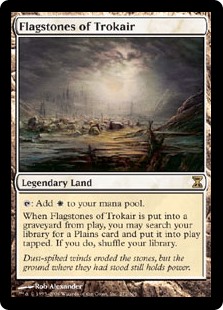 8-Rack wants to bring games to a low-resource state for both players, so Tom Ross avoids high-curve cards and value engines. BW Shadow Pox has a different gameplan, though. We use Smallpox to pull ahead of opponents early on, and induce stumbling across the table. That way, they'll have a harder time dealing with the threats we throw at them, which each attack from different angles, or keeping up with us once our value engines get going.
8-Rack wants to bring games to a low-resource state for both players, so Tom Ross avoids high-curve cards and value engines. BW Shadow Pox has a different gameplan, though. We use Smallpox to pull ahead of opponents early on, and induce stumbling across the table. That way, they'll have a harder time dealing with the threats we throw at them, which each attack from different angles, or keeping up with us once our value engines get going.
It can't be overstated that while 8-Rack and BW Shadow Pox are both Smallpox decks, they use the card for different purposes and have different gameplans. Some cards Tom advises against in 8-Rack, like Flagstones of Trokair, are natural fits here. Our dream curve is turn one Urbrog, Inquisition; turn two Flagstones, Smallpox; turn three planeswalker. We're fine with opponents making their land drops eventually; we just want it not to matter by the time they do. 8-Rack aims to strip the gamestate down to nothing and win before opponents can rebuild, while this deck aims to mana-screw opponents early and flood them late. For both decks, Smallpox is integral.
Threats
Death's Shadow and Gurmag Angler are threats opponents must answer, lest they close out the game. Once they've been killed, Smallpox becomes live again, and if they go unmolested, our opponent simply becomes dead. Both threats also play excellent defense, which actual creatures should; it's something the fatties have over Bloodghast & co.
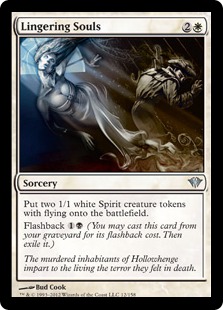 Lingering Souls fills multiple roles in this deck. It's an easy way to turn Smallpox back on when we've got a fatty in play, but that's more vestigial. The combat potential of 1/1 Spirits houses the card's true value. Besides its synergy with our self-discard effects, which gives us Spirits on the cheap, Lingering Souls represents a sizable aerial threat at four whole damage. By flying and going wide at once, it incentivizes opponents to have a very specific type of answer that doesn't do anything against the rest of our deck—gumming up the ground with Shadows of their own won't cut it, and spot removal leaves much to be desired in the face of a token horde. Souls also provides some much-needed defense for decks like Affinity, and can chump four times when we need to buy time or protect our planeswalkers.
Lingering Souls fills multiple roles in this deck. It's an easy way to turn Smallpox back on when we've got a fatty in play, but that's more vestigial. The combat potential of 1/1 Spirits houses the card's true value. Besides its synergy with our self-discard effects, which gives us Spirits on the cheap, Lingering Souls represents a sizable aerial threat at four whole damage. By flying and going wide at once, it incentivizes opponents to have a very specific type of answer that doesn't do anything against the rest of our deck—gumming up the ground with Shadows of their own won't cut it, and spot removal leaves much to be desired in the face of a token horde. Souls also provides some much-needed defense for decks like Affinity, and can chump four times when we need to buy time or protect our planeswalkers.
Shambling Vent is my creature land of choice. As mentioned, we tend to accrue resources with this deck, and can therefore afford its activation cost. I like having access to lifegain in the mainboard on a Shadow plan, and 2/3 are surprisingly relevant stats in this Bolt-light Modern. Another draw to this land is its mana-fixing property. Favoring Mutavault increases our risk of bricking on colors when we consistently need WW or BB in the early turns.
Planeswalkers
As with 8-Rack, Liliana of the Veil is our best walker. She destroys hands and keeps the board clear while dealing with problematic permanents in the late-game.
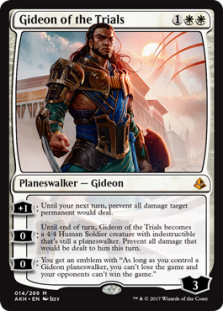
Gideon of the Trials is actually amazing in this deck. He combines well with our other walkers by forcing opponents to stick multiple creatures to break through; with Gideon neutralizing a threat, our removal can usually keep a second at bay, giving us time to tick Liliana back up. Decks that want to beat us off the board have Gideon's emblem to think about, which combined with our kill spells is enough to lock many opponents out. And Gideon even turns sideways once opponents run out of cards.
Liliana, the Last Hope covers many of the weaknesses of Liliana of the Veil. While the latter can struggle against mana dorks or creature tokens, for instance, the Last Hope provides a literal bullet stream of value and tempo. Her minus recurs dead Shadows and can even draw us cards with Street Wraith.
Interaction
As Modern's Shadow decks and Jund before them have shown us time and again, Inquisition and Thoughtseize are some of the most powerful interactive spells in the format. Here, they take away crucial early pieces to give us time to set up with a planeswalker, and clear the path for our important spells later on. We don't mind pacing our discard spells, unlike 8-Rack, which often wants to cast them as soon as possible to maximize its mana usage and damage output.
The Fatal Pushes help with faster creature decks that can power through a discard spell and a Smallpox. Between our many planeswalkers and fatties, we don't need as much removal as 8-Rack does, but it's important to have a little.
Sideboard
I haven't yet put in the reps to have a tuned sideboard (in other words, a tuned 75), but this is where I'm starting. It's a pile of removal, sweepers, hosers, and utility spells.
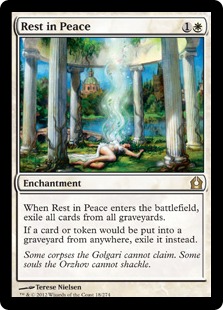
Since BW Shadow Pox attacks from many angles, graveyard hate is weak against us—only four of our cards care, excluding Liliana, the Last Hope. And Lingering Souls is serviceable either way, meaning it's really just the two Anglers that lose out if opponents stick a Rest in Peace. So we play our own Rest in Peaces, as well as Stony Silences. These white enchantments are largely responsible for players praising white as Modern's "sideboard color." They put in work.
It's too bad I couldn't find room for Collective Brutality in the main; this card is nuts. Another card I want to mention directly is Anguished Unmaking, which I think doesn't see play mainly because it lacks a home. Unmaking is a highly flexible (if pricey) card I think will catch on in some decks down the road, providing a similar function to Engineered Explosives.
A Pox on Both Your Houses
BW Shadow Pox is far from optimized. It needs a good deal of jamming and tuning that I'm not really up for—come the end of the weekend, my interest in this kind of deck will have likely started waning. But I think the strategy has potential, as many do in Modern. Either way, Smallpox is a powerful, unique card that's a blast to brew around. Congrats to Tom on his finish, and thanks for inspiring me to dig up this little number.





Spicy list! I like this take on Smallpox. I suppose the new planeswalker rule is the rationale behind running 4 LiliVeil and 2 LiliLastHope over Lingering Souls 3-4 in the main?
That, and I don’t want to overcommit into a single angle of attack. I’d rather run more ‘walkers as three-drops since LtlH helps address certain issues the deck has and pressures opponents from a unique angle. There are few effective ways to remove a PW in Modern, while answers to Lingering Souls abound.
I’m really looking forward to see what kind of smallpox deck you will brew (if this list isn’t already good enough).
I’ve been testing a Mardu smallpox version with faithless looting, bloodghast, lingering souls and boom/bust.
Even with the clunky Mana base, the idea is to break even more the symmetry on different angles and with micro synergies.
Turn 1 faithless discarding bloodghast and/or souls is wonderful.
Turn 2 urborg/flagstones into smallpox is the default to any smallpox.
But, if you can’t have urborg, you can boom bust your flagstones, fixing your Mana and destroying the opposing lands.
You can even target your fetchlands with boom/bust.
To close the game: Gideon of trials and/or gurmag angler.
I love Looting in general, but in decks that can benefit off the grave dump, it’s superb. I don’t usually run it in my Pox decks because it makes the mana miserable. Trying to support Looting, Pox, and Flagstones in one deck stretches us very thin, and makes us too soft to land destruction IMO. You also risk delving too deep into graveyard synergies at that point, so Rest in Peace & co. become great against us as well.
Going all-in on the land destruction plan can be fun, and I’ve tried it a few times. It’s good in some matchups, but super weak against anyone proactive. If opponents stick an early threat (or, God forbid, two), we just lose. Land destruction spells are also pretty weak in the late-game; Smallpox itself sort of has this problem too, but it’s passable since it still kills creatures. It also asks a lot of the deck. Often we can’t cast BB on turn two for value and have to wait until turn three (i.e. with a fetch), which is too late most of the time. Easy to draw the wrong pieces at the wrong time.
Never seen anything like this– my God it’s like your discovered something new
Interesting brew. Four Fetid Heath plus eight legendary lands seems like it might be pushing the envelope pretty hard though. Though I guess Flagstones doesn’t really suffer from the legendary rule the same way that Urborg does. Are you tracking mulls for wrong land combinations in the opener, as opposed to mulls for wrong number of lands in the opener?
Definitely not tracking. You just really want to open Urborg though. Smallpox lets you sacrifice/dump extras, and you can also pitch them to Lili. So far having more Urborgs never loses me the game, but missing the first one can.